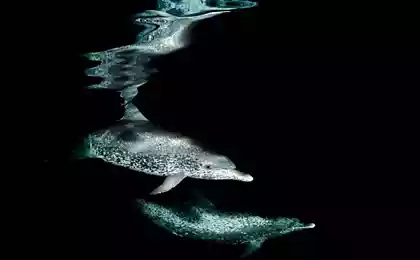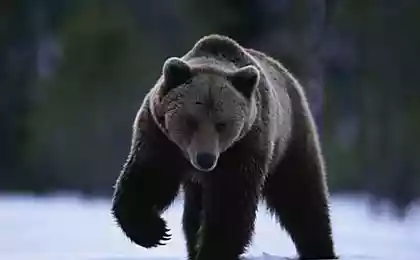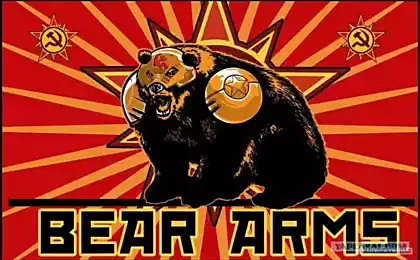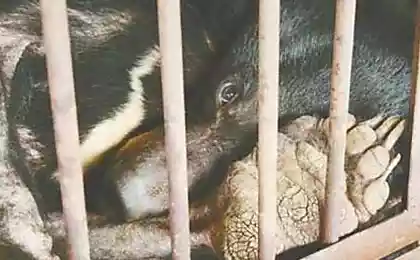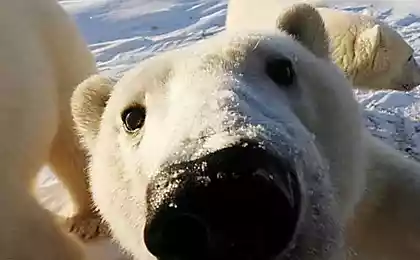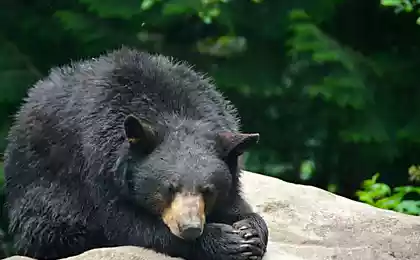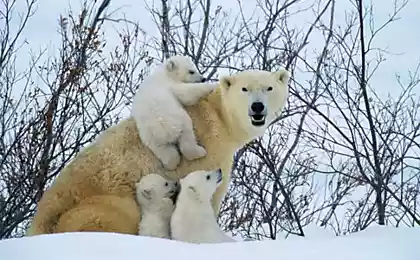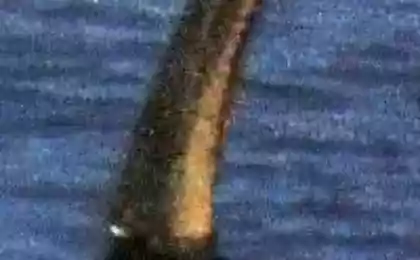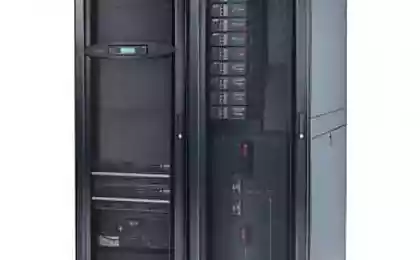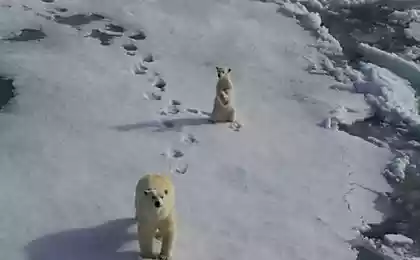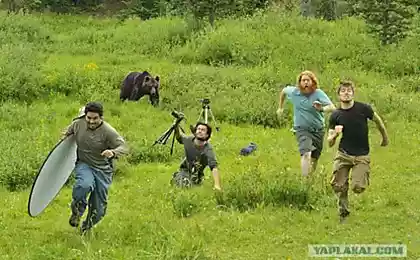635
What happens to the body of a bear during hibernation? The comment of the expert
Fifty nine million six hundred thirty one thousand four hundred twenty
Every autumn the bears of temperate and polar latitudes (in particular brown and black) begin to prepare for hibernation. All spring, summer and autumn these animals were actively feeding on nagoeva fat reserves for the winter. And now that the cold is approaching, they are looking for a suitable shelter to spend the winter. After the shelter was found, the bear goes into hibernation.
Hibernation of bears in some cases lasts up to six months. During hibernation, some species such as black bear (Ursus americanus), lower pulse rate of 55 beats per minute to about 9. The rate of metabolism is reduced by 53%. Of course, all this time, bears do not eat, do not drink and do not produce wastes. How do they do it?
To understand what is happening in the body of a bear during hibernation, you must immediately clarify what is a very dormant. And why it is not "suspended animation" in the truest sense of the word. In the literal sense of the term "suspended animation" is a process full of inactivity of the animal. At this time, the rate of metabolism reduced to levels that for most higher animals is incompatible with life.
Some species of amphibians (newts and some frogs) freeze in the cold, without harm to themselves thaw with the onset of warm season. Painless it's "freezing" literally through to them is in connection with the production of specific substances with properties of antifreeze that prevents freezing of water in their body.
Bears do not freeze. Their body temperature during hibernation is quite high, allowing them to Wake up in case of any danger, coming out of the den. By the way, bears that woke up early, called "rods". They pose a significant risk to humans, as in winter, the bear can't find enough food and is always hungry, and aggressive.
Some researchers argue that bears do not fall into suspended animation, as mentioned above. But there are scientists who call the bears "super babysnake" because not eat, drink or defecate for six months, while being able to quickly emerge from hibernation is a unique phenomenon in the animal world.
"In my opinion, bears are the best anabiotic in the world," says Brian Barnes (Brian Barnes) from the Institute of Arctic biology University of Alaska (Fairbanks). This scientist spent three years studying the features of hibernation black bears.
"Their bodies are a closed system. They can spend all winter using only oxygen for breathing is all they need," says Barnes.
Why bears do not defecate during hibernation? In short, it is because in their body at this time forms a fecal plug. This is a special mass, which researchers have been found in the esophagus bears, fallen into hibernation.
Previously it was thought that the bears before getting in the den, eat large quantities of plant material, fur other bears and other materials that are not digested, and which then form a plug in the intestine of the animal. Scientists who have come to this conclusion, relied heavily on information obtained from the bear hunters. They argued that the way of eating, outlined above, has led to the "bowel bond" and the animal just couldn't during sleep to hold the act of defecation.
In fact, it is not. Bears nothing to eat before hibernation. They're like omnivores, I try to consume any available food, including fruits, vegetables, nuts, meat, fish, berries and more.
Seventy eight million three hundred nineteen thousand four hundred ninety three
But during hibernation the animal's gut continues to work. Not in continue to activity, but it works. Cells continue to divide, is intestinal secretion. This creates a small amount of faeces that accumulates in the intestine of the animal. Formed a "tube" with a diameter of 3.8 to 6.4 centimeters.
"Fecal tube is the same wastes that are found in the intestines of the animal for so long that the walls of the intestines absorb fluid from this mass, leaving it dry and solid," — said on the website of the North American center for the study of bears. Thus, the body of a bear does not lose this necessary water reserves in the den to fill virtually impossible.
Specialists were placed in the dens of bears camera that was recording everything that happens during hibernation. As it turned out, the fibres of plants and wool are often an integral part of the tube because even a bear during hibernation can pick up something from the ground in the den, and maybe lick their fur.
One million one hundred forty six thousand four hundred sixteen
After bear emerges from the den, they cleanse the intestines, which begins to function normally. Normally defecation takes place already on the threshold of the den. So no mystery or riddles, as they say some hunters or even scientists, bear no stopper. All this — the waste products of the body. By the way, the bear den is not sucking his paw. The fact that in January and February there is a change of the skin on the paws. Old skin bursts, itchy, what causes the bear is known to inconvenience. In order to relieve the itching, the bear licks his paws.
In order to clarify the details of the process of the hibernation of bears, I requested a review from scientists from the Krivoy Rog state pedagogical University.
How bears support your body in a state of hibernation?Each animal exists at the expense of metabolism and energy, which are provided by the consumption of food. Naturally, the more active lifestyles and more intense physiological processes, the more "fuel" in the form of food, you need to enter the body. In the body, staying dormant in hibernation, the intensity of all metabolic processes is reduced to the physiological minimum. That is, energy is expended as much as it is necessary in order for the animal to remain alive and to avoid degenerative processes in the tissues and organs in connection with the lack of energy. In General, this condition can be compared with what occurs during normal sleep, but, of course, it is more "exaggerated".
The main consumer of energy in the body are the brain and muscle (at least 2/3 of the total energy of the body). But because the muscular system during sleep is inactive, the energy cells get as much as necessary to maintain their existence. Therefore, "idle" begin to work and other organs also receive very little energy. Digestive system in fact nothing to digest it (as the intestine is almost empty, as mentioned above). Where, then, does the minimum amount of energy that the animal needed? It is derived from fat reserves and glycogen accumulated during the active period of the year. They are spent gradually and usually enough until spring.
By the way, the rods often become those bears that summer "ate poorly". There are many oral stories that rods in the lean years more. So, fat reserves and glycogen is the main source of energy. Another vital substance is oxygen. But since the body is inactive, and oxygen needs are much less. Thus, the respiratory rate is greatly reduced. But if the tissues of the body during hibernation require a very small amount of oxygen and nutrients, and the blood which transfers to move much slower. Therefore, the heart rate is significantly reduced, and accordingly, the heart also consumes less energy. Saving water is not only the "clogging" of the intestine, but the actual suspension of activity of the kidneys.
Are there other examples of dormancy among warm-blooded animals?Such device as the hibernation of bears is highly unusual for warm-blooded phenomenon, but not unique. It also have urchins of temperate latitudes, inhabitants of the steppes of Eurasia Surkov, some members of the family Mustelidae (badger). Especially in the cold and hungry winter in this state can get squirrels and raccoon dogs, but not for long, and their processes of life not slowing down as is the case with bears. In addition to hibernation (hibernate), and there is also a summer hibernation (activate). Last fall some of the inhabitants of the hot deserts (some insectivores, rodents, marsupials).
It happens in the hottest periods of the year when the production of food and water become much more energy-intensive and, in fact, ineffective. So the animal is easier to hibernate and wait out the unfavorable conditions. In addition to seasonal dormancy and also it happens daily. It is typical for some warm-blooded flying – hummingbirds and bats. The fact that some, and others during flight very quickly waving their wings. Due to this, their flight is more maneuverable, and production of feed more efficient. But for all the nature you need to pay. Their flying muscles consume a lot of energy, which is not enough for a full day (despite the fact that hummingbirds and bats during the active phase of the day consume food a lot more than half its own weight).
As you can see, the rate of metabolism is simply enormous. Therefore while you sleep (and rest in form of sleep required each animal – this is also normal and physiological process mandatory) their livelihoods reduced to parameters comparable to those observed in bears.
What is the state of hibernation of bears from, for example, hibernation of frogs?In warm-blooded physiological processes during hibernation may not be fully "off". Then, they are warm-blooded – must be self-generated heat. A different picture can be observed in poikilothermic animals, their life processes to almost completely stop. That is, the cells are practically dormant until better times – when the sun warms and give enough heat, to warm up the body. It happens in all amphibians temperate and more Northern latitudes.
A well-known fact that individuals of caudate amphibians of the Siberian uglozuba once was literally frozen in ice for several decades (!) after thawing was "revived" and felt quite normal. Also in the fall hibernation and overwintering of snakes and lizards, but their body is not as resilient (freezing they do not outsource). Another example is fish that lives in ephemeral ponds in Africa, South America and Australia, and buried in the mud in times of drought. The processes occurring in their body during this period are close to those that occur in amphibians – the almost complete suspension of activity until better times.
As for reptiles from tropical countries, it must be said that, although they are cold-blooded, but experiencing the adverse conditions they are more similar to those of the warm-blooded – a significant reduction in the intensity of physiological processes, but not stop (solar thermal energy it is enough). Large reptiles (crocodiles, pythons, and Boas), so "rest" before the year, digesting the eaten large prey.
Is it possible to artificially create a mode of hibernation for animals that don't hibernate?No. It will be an abnormal state like a coma.
How could there be such a mechanism the hibernation of the bears? Worked out whether this mechanism for many hundreds of thousands of years or appeared spontaneously?All physiological processes are controlled genetically. In the course of evolution in a particular group of individuals could produce a physiological feature consists in the special sleep mode (daily, normal) in the cold period of the year, accompanied by a slight decline of physiological activity and the fall in body temperature by 1-2 degrees.
This feature has given these species an advantage in terms of more economical use of energy in the conditions with less feed. However, she began to give so great an advantage in survival that gradually populations remained only such mutants. Further selection on this basis continued between the sleep became longer and deeper, and the intensity processes of the organism decreased more and more. Finally the animals have learned to build dens. By the way, this feature could give significant advantage also because during hibernation the female gives birth to cubs, and they are at this time in warmth and protection, hidden from prying eyes. In General, the evolution of the phenomenon of hibernation continued (and perhaps continues) for certainly not less than several hundred thousand years.
For assistance in preparing the article, the editors Geektimes thanks:
Brosco, Eugene O., C.b.N., senior lecturer, Department of Zoology of the University (Kryvyi Rih state pedagogical University)
Yevtushenko, Edward A., C.b.N., associate Professor, Department of botany and ecology, University
Source: geektimes.ru/post/281386/
Every autumn the bears of temperate and polar latitudes (in particular brown and black) begin to prepare for hibernation. All spring, summer and autumn these animals were actively feeding on nagoeva fat reserves for the winter. And now that the cold is approaching, they are looking for a suitable shelter to spend the winter. After the shelter was found, the bear goes into hibernation.
Hibernation of bears in some cases lasts up to six months. During hibernation, some species such as black bear (Ursus americanus), lower pulse rate of 55 beats per minute to about 9. The rate of metabolism is reduced by 53%. Of course, all this time, bears do not eat, do not drink and do not produce wastes. How do they do it?
To understand what is happening in the body of a bear during hibernation, you must immediately clarify what is a very dormant. And why it is not "suspended animation" in the truest sense of the word. In the literal sense of the term "suspended animation" is a process full of inactivity of the animal. At this time, the rate of metabolism reduced to levels that for most higher animals is incompatible with life.
Some species of amphibians (newts and some frogs) freeze in the cold, without harm to themselves thaw with the onset of warm season. Painless it's "freezing" literally through to them is in connection with the production of specific substances with properties of antifreeze that prevents freezing of water in their body.
Bears do not freeze. Their body temperature during hibernation is quite high, allowing them to Wake up in case of any danger, coming out of the den. By the way, bears that woke up early, called "rods". They pose a significant risk to humans, as in winter, the bear can't find enough food and is always hungry, and aggressive.
Some researchers argue that bears do not fall into suspended animation, as mentioned above. But there are scientists who call the bears "super babysnake" because not eat, drink or defecate for six months, while being able to quickly emerge from hibernation is a unique phenomenon in the animal world.
"In my opinion, bears are the best anabiotic in the world," says Brian Barnes (Brian Barnes) from the Institute of Arctic biology University of Alaska (Fairbanks). This scientist spent three years studying the features of hibernation black bears.
"Their bodies are a closed system. They can spend all winter using only oxygen for breathing is all they need," says Barnes.
Why bears do not defecate during hibernation? In short, it is because in their body at this time forms a fecal plug. This is a special mass, which researchers have been found in the esophagus bears, fallen into hibernation.
Previously it was thought that the bears before getting in the den, eat large quantities of plant material, fur other bears and other materials that are not digested, and which then form a plug in the intestine of the animal. Scientists who have come to this conclusion, relied heavily on information obtained from the bear hunters. They argued that the way of eating, outlined above, has led to the "bowel bond" and the animal just couldn't during sleep to hold the act of defecation.
In fact, it is not. Bears nothing to eat before hibernation. They're like omnivores, I try to consume any available food, including fruits, vegetables, nuts, meat, fish, berries and more.
Seventy eight million three hundred nineteen thousand four hundred ninety three
But during hibernation the animal's gut continues to work. Not in continue to activity, but it works. Cells continue to divide, is intestinal secretion. This creates a small amount of faeces that accumulates in the intestine of the animal. Formed a "tube" with a diameter of 3.8 to 6.4 centimeters.
"Fecal tube is the same wastes that are found in the intestines of the animal for so long that the walls of the intestines absorb fluid from this mass, leaving it dry and solid," — said on the website of the North American center for the study of bears. Thus, the body of a bear does not lose this necessary water reserves in the den to fill virtually impossible.
Specialists were placed in the dens of bears camera that was recording everything that happens during hibernation. As it turned out, the fibres of plants and wool are often an integral part of the tube because even a bear during hibernation can pick up something from the ground in the den, and maybe lick their fur.
One million one hundred forty six thousand four hundred sixteen
After bear emerges from the den, they cleanse the intestines, which begins to function normally. Normally defecation takes place already on the threshold of the den. So no mystery or riddles, as they say some hunters or even scientists, bear no stopper. All this — the waste products of the body. By the way, the bear den is not sucking his paw. The fact that in January and February there is a change of the skin on the paws. Old skin bursts, itchy, what causes the bear is known to inconvenience. In order to relieve the itching, the bear licks his paws.
In order to clarify the details of the process of the hibernation of bears, I requested a review from scientists from the Krivoy Rog state pedagogical University.
How bears support your body in a state of hibernation?Each animal exists at the expense of metabolism and energy, which are provided by the consumption of food. Naturally, the more active lifestyles and more intense physiological processes, the more "fuel" in the form of food, you need to enter the body. In the body, staying dormant in hibernation, the intensity of all metabolic processes is reduced to the physiological minimum. That is, energy is expended as much as it is necessary in order for the animal to remain alive and to avoid degenerative processes in the tissues and organs in connection with the lack of energy. In General, this condition can be compared with what occurs during normal sleep, but, of course, it is more "exaggerated".
The main consumer of energy in the body are the brain and muscle (at least 2/3 of the total energy of the body). But because the muscular system during sleep is inactive, the energy cells get as much as necessary to maintain their existence. Therefore, "idle" begin to work and other organs also receive very little energy. Digestive system in fact nothing to digest it (as the intestine is almost empty, as mentioned above). Where, then, does the minimum amount of energy that the animal needed? It is derived from fat reserves and glycogen accumulated during the active period of the year. They are spent gradually and usually enough until spring.
By the way, the rods often become those bears that summer "ate poorly". There are many oral stories that rods in the lean years more. So, fat reserves and glycogen is the main source of energy. Another vital substance is oxygen. But since the body is inactive, and oxygen needs are much less. Thus, the respiratory rate is greatly reduced. But if the tissues of the body during hibernation require a very small amount of oxygen and nutrients, and the blood which transfers to move much slower. Therefore, the heart rate is significantly reduced, and accordingly, the heart also consumes less energy. Saving water is not only the "clogging" of the intestine, but the actual suspension of activity of the kidneys.
Are there other examples of dormancy among warm-blooded animals?Such device as the hibernation of bears is highly unusual for warm-blooded phenomenon, but not unique. It also have urchins of temperate latitudes, inhabitants of the steppes of Eurasia Surkov, some members of the family Mustelidae (badger). Especially in the cold and hungry winter in this state can get squirrels and raccoon dogs, but not for long, and their processes of life not slowing down as is the case with bears. In addition to hibernation (hibernate), and there is also a summer hibernation (activate). Last fall some of the inhabitants of the hot deserts (some insectivores, rodents, marsupials).
It happens in the hottest periods of the year when the production of food and water become much more energy-intensive and, in fact, ineffective. So the animal is easier to hibernate and wait out the unfavorable conditions. In addition to seasonal dormancy and also it happens daily. It is typical for some warm-blooded flying – hummingbirds and bats. The fact that some, and others during flight very quickly waving their wings. Due to this, their flight is more maneuverable, and production of feed more efficient. But for all the nature you need to pay. Their flying muscles consume a lot of energy, which is not enough for a full day (despite the fact that hummingbirds and bats during the active phase of the day consume food a lot more than half its own weight).
As you can see, the rate of metabolism is simply enormous. Therefore while you sleep (and rest in form of sleep required each animal – this is also normal and physiological process mandatory) their livelihoods reduced to parameters comparable to those observed in bears.
What is the state of hibernation of bears from, for example, hibernation of frogs?In warm-blooded physiological processes during hibernation may not be fully "off". Then, they are warm-blooded – must be self-generated heat. A different picture can be observed in poikilothermic animals, their life processes to almost completely stop. That is, the cells are practically dormant until better times – when the sun warms and give enough heat, to warm up the body. It happens in all amphibians temperate and more Northern latitudes.
A well-known fact that individuals of caudate amphibians of the Siberian uglozuba once was literally frozen in ice for several decades (!) after thawing was "revived" and felt quite normal. Also in the fall hibernation and overwintering of snakes and lizards, but their body is not as resilient (freezing they do not outsource). Another example is fish that lives in ephemeral ponds in Africa, South America and Australia, and buried in the mud in times of drought. The processes occurring in their body during this period are close to those that occur in amphibians – the almost complete suspension of activity until better times.
As for reptiles from tropical countries, it must be said that, although they are cold-blooded, but experiencing the adverse conditions they are more similar to those of the warm-blooded – a significant reduction in the intensity of physiological processes, but not stop (solar thermal energy it is enough). Large reptiles (crocodiles, pythons, and Boas), so "rest" before the year, digesting the eaten large prey.
Is it possible to artificially create a mode of hibernation for animals that don't hibernate?No. It will be an abnormal state like a coma.
How could there be such a mechanism the hibernation of the bears? Worked out whether this mechanism for many hundreds of thousands of years or appeared spontaneously?All physiological processes are controlled genetically. In the course of evolution in a particular group of individuals could produce a physiological feature consists in the special sleep mode (daily, normal) in the cold period of the year, accompanied by a slight decline of physiological activity and the fall in body temperature by 1-2 degrees.
This feature has given these species an advantage in terms of more economical use of energy in the conditions with less feed. However, she began to give so great an advantage in survival that gradually populations remained only such mutants. Further selection on this basis continued between the sleep became longer and deeper, and the intensity processes of the organism decreased more and more. Finally the animals have learned to build dens. By the way, this feature could give significant advantage also because during hibernation the female gives birth to cubs, and they are at this time in warmth and protection, hidden from prying eyes. In General, the evolution of the phenomenon of hibernation continued (and perhaps continues) for certainly not less than several hundred thousand years.
For assistance in preparing the article, the editors Geektimes thanks:
Brosco, Eugene O., C.b.N., senior lecturer, Department of Zoology of the University (Kryvyi Rih state pedagogical University)
Yevtushenko, Edward A., C.b.N., associate Professor, Department of botany and ecology, University
Source: geektimes.ru/post/281386/

